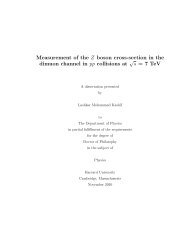2 The CDF Experiment at Fermilab Contents - Harvard University ...
2 The CDF Experiment at Fermilab Contents - Harvard University ...
2 The CDF Experiment at Fermilab Contents - Harvard University ...
You also want an ePaper? Increase the reach of your titles
YUMPU automatically turns print PDFs into web optimized ePapers that Google loves.
Section 2: W Mass 55<br />
problem we are seeing may also have been present in Run Ia as the Z mass obtained<br />
from these d<strong>at</strong>a is consistent with both the CERN result of 91:187 GeV as well as a<br />
number 410 MeV lower.<br />
A better momentum measurement is obtained by including a beam constraint in the<br />
track it. This constraint tends to bias electrons which have radi<strong>at</strong>ed towards higher<br />
P T , and if we are not simul<strong>at</strong>ing the beam constraint correctly, we may fail to correct<br />
for this bias. From the impact parameter resolution, the width of the E/p distribution,<br />
and correl<strong>at</strong>ion between E/p and impact parameter, we can see th<strong>at</strong> the Monte Carlo<br />
covariance m<strong>at</strong>rix does not perfectly describe the d<strong>at</strong>a. We have tried perturbing<br />
the covariance m<strong>at</strong>rix, including tting to the d<strong>at</strong>a directly, but we have seen only<br />
negligible changes in the E/p peak position.<br />
Radi<strong>at</strong>ive decays W ! e modify the E/p distribution. If they are not simul<strong>at</strong>ed<br />
correctly, asystem<strong>at</strong>ic error could result. We nd th<strong>at</strong> internal Bremsstrahlung shifts<br />
the E/p peak by :25%. If our gener<strong>at</strong>or is wrong by 100%, then this might<br />
account for some of the eect we are seeing. Our default gener<strong>at</strong>or is PHOTOS,<br />
but we have also tried using a Berends and Kleiss calcul<strong>at</strong>ion [14], as well as a more<br />
recent calcul<strong>at</strong>ion by Baur, Keller, and Wackeroth [15]. We have also implemented<br />
an algorithm by Laporta and Odorico [16], and all these calcul<strong>at</strong>ions give the same<br />
results. All these calcul<strong>at</strong>ions, of course, are based on the same physics, nonetheless<br />
the similarity of the results makes it unlikely th<strong>at</strong> there is a bug in the gener<strong>at</strong>or code,<br />
or our implement<strong>at</strong>ion of it.<br />
Recently <strong>CDF</strong> has re-calcul<strong>at</strong>ed the CTC calibr<strong>at</strong>ion and alignment. While this improves<br />
the P T resolution by 10%, the E/p peak position does not change.<br />
<strong>The</strong> ALEPH and KTeV Collabor<strong>at</strong>ions have observed system<strong>at</strong>ic dierences in tracking<br />
electrons as compared to muons and pions. This is thought to come from the eects of<br />
keV level photons emitted by the electron as it passes through the gas. <strong>The</strong> sensitivity<br />
to these photons depends gre<strong>at</strong>ly on tracking algorithms. We modeled these eects<br />
in detail and showed th<strong>at</strong> they would be important only if they were ten or twenty<br />
times larger. We also compared exhaustively the properties of the electron and muon<br />
tracks from W and Z decays and found no important dierence. Finally, we compared<br />
the masses for J= and obtained from electron tracks and, taking into account the<br />
rel<strong>at</strong>ively large radi<strong>at</strong>ive corrections for electrons, observed good agreement with the















